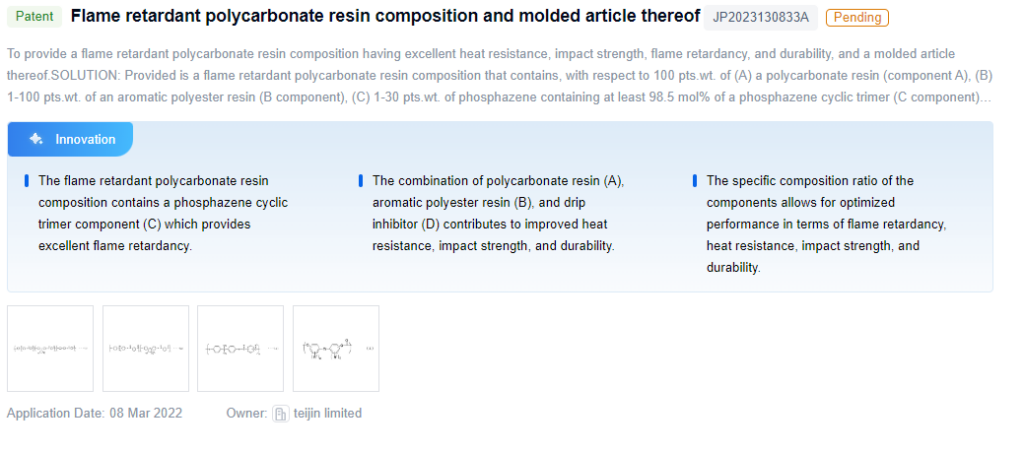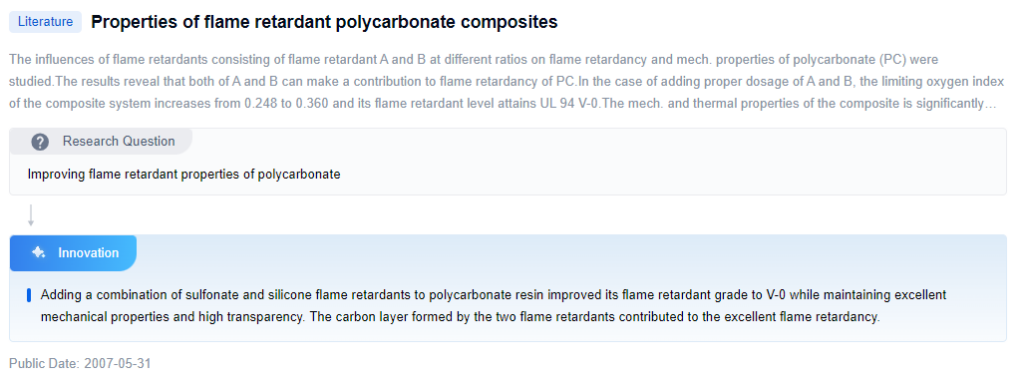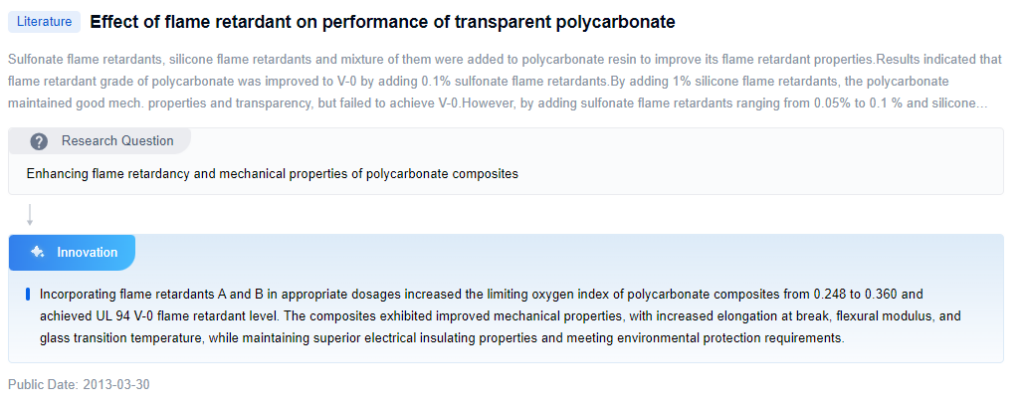
Polycarbonate Flame Retardancy Goals
Enhancing the flame retardant performance of polycarbonate (PC) is critical in industries like electronics, automotive, and construction, where fire safety is paramount. The main objectives include:
- Achieving High Flame Retardancy: Targeting a V-0 rating in the UL 94 test to ensure maximum fire resistance.
- Reducing Toxic Gas Emissions: Minimizing harmful emissions during combustion, such as carbon monoxide and halogenated compounds.
- Preserving Material Properties: Maintaining transparency, impact strength, and thermal stability while improving flame resistance.
- Developing Cost-Effective, Eco-Friendly Solutions: Creating affordable, environmentally compliant flame retardants for broader application.
These goals focus on improving fire safety without compromising the key qualities of polycarbonate, supporting safer and more sustainable applications across various industries.

To get a detailed scientific explanations of polycarbonate, try Eureka.
Market Demand for Flame Retardant Polycarbonate
The demand for flame retardant polycarbonate (FR-PC) is growing due to stringent fire safety regulations and the need for high-performance materials. The construction sector heavily relies on FR-PC for electrical enclosures, lighting fixtures, and interior components. In the transportation industry, particularly automotive and aerospace, FR-PC is used in interior components to meet fire safety standards while reducing vehicle weight. The electrical and electronics industry also drives demand, using FR-PC in housings, connectors, and insulation materials. Additionally, the push for sustainability has spurred interest in halogen-free and eco-friendly flame retardant solutions, fueling further market growth.
Automotive and Aerospace Sectors
- Automotive manufacturers use FR-PC for interior components like instrument panels and electrical housings, aiming to meet fire safety standards and reduce vehicle weight.
- In aerospace, FR-PC is favored for cabin interiors and structural applications due to its flame retardancy, low smoke emission, and high strength-to-weight ratio.
Electrical and Electronics Industry
- FR-PC is widely used in housings and insulation materials for electrical devices, meeting the growing demand for energy-efficient, environmentally friendly products.
Sustainability and Environmental Regulations
- The emphasis on sustainability has driven the adoption of halogen-free and eco-friendly flame retardant solutions, creating opportunities for innovative FR-PC materials.
Current State and Challenges in Polycarbonate Flame Retardancy

Polycarbonate is widely used for its mechanical properties, transparency, and heat resistance, but its flammability limits its application in fire-critical areas. Enhancing flame retardancy often involves incorporating additives, which can be halogenated or halogen-free. Halogenated flame retardants are effective but raise environmental concerns, leading to a shift toward sustainable alternatives. Halogen-free options, like inorganic or phosphorus-based compounds, offer better environmental profiles but may require higher loading, affecting the material’s properties.
Challenges with Flame Retardant Additives
- Achieving a balance between flame retardancy and maintaining the mechanical, optical, and thermal properties of polycarbonate is challenging.
- Ensuring compatibility and dispersion of flame retardant additives within the polycarbonate matrix is crucial to avoid compromising effectiveness and causing defects.
Global Research and Collaboration
- Research efforts are geographically diverse, with significant contributions from North America, Europe, and Asia. Collaboration among academic institutions, research organizations, and industrial players is key to advancing this field.
Evolution of Flame Retardant Technologies for Polycarbonate

Existing Solutions for Polycarbonate Flame Retardancy
Flame Retardant Polycarbonate Compositions
Various compositions incorporate flame retardant additives, either halogenated or halogen-free, into polycarbonate resins to enhance fire resistance while maintaining other properties like impact resistance and transparency.
Improved Thermal Stability and Flow Properties
Some compositions are designed for improved thermal stability and better processing flow properties, crucial for applications requiring high-temperature performance.
Non-Halogenated Flame Retardant Polycarbonates
To address environmental concerns, non-halogenated flame retardants, such as phosphorus-based compounds, are increasingly used in polycarbonate formulations.
Flame Retardant Polycarbonate Alloys and Blends
Polycarbonate can be alloyed with other polymers, such as polyetherimides, to create compositions with enhanced flame retardancy, thermal stability, or impact resistance.
Bio-Based and Sustainable Flame Retardant Polycarbonates
Interest in sustainability has led to the development of bio-based polycarbonate compositions that incorporate renewable resources or recycled materials while maintaining fire resistance.
Key Players in Flame Retardant Polycarbonate Industry
The competitive landscape for improving polycarbonate flame retardancy involves key players at different stages of industry development, market size, and technology maturity.
Covestro Deutschland AG
Covestro has developed halogen-free flame retardant polycarbonates, focusing on thermal stability and reducing smoke production.
SABIC Global Technologies BV
SABIC’s flame retardant solutions incorporate proprietary additives to enhance flame resistance while maintaining mechanical properties.
Trinseo Europe GmbH
Trinseo uses phosphorus-based flame retardants combined with synergistic agents to achieve high flame retardancy with minimal impact on transparency.
Purinova Sp zoo
Purinova develops flame retardant polycarbonates through innovative chemical modifications, enhancing ignition resistance and reducing toxic gas emissions.
Changzhou Aopude Plastic Industry Co. Ltd.
Changzhou Aopude focuses on inorganic flame retardants combined with synergistic agents to provide high flame retardancy while maintaining mechanical strength.
Core Innovations in Flame Retardant Polycarbonate
Patent 1: Flame Retardant Polycarbonate Composition with High Comparative Tracking Index
This invention involves a polycarbonate composition with optimized weight ratios for improved flame retardancy and flowability. The copolycarbonate provides enhanced comparative tracking index (CTI) and flame retardancy properties.

Patent 2: Flame Retardant Polycarbonate Resin Composition and Molded Article
This patent describes a polycarbonate resin composition containing a phosphazene cyclic trimer, which offers excellent flame retardancy, heat resistance, impact strength, and durability.

Paper 1: Properties of Flame Retardant Polycarbonate Composites
Adding sulfonate and silicone flame retardants to polycarbonate resin improves its flame retardant grade to V-0, maintaining mechanical properties and high transparency.

Paper 2: Effect of Flame Retardant on Performance of Transparent Polycarbonate
Incorporating specific flame retardants increases the limiting oxygen index and achieves a UL 94 V-0 flame retardant level while enhancing mechanical properties and environmental safety.

Potential Breakthroughs in Polycarbonate Flame Retardancy
Halogenated Flame Retardant Polycarbonate Compositions
Certain compositions incorporate halogenated compounds like brominated or chlorinated flame retardants to improve fire resistance.
Non-Halogenated Flame Retardant Polycarbonate Compositions
To address environmental concerns, non-halogenated flame retardants, such as phosphorus-based or inorganic compounds, are used to enhance fire resistance.
Polycarbonate Blends with Improved Flame Retardancy
Polycarbonate blends with other polymers or additives can enhance flame retardancy while maintaining mechanical properties.
Flame Retardant Polycarbonate Compositions for Specific Applications
Tailored compositions meet the flame retardancy needs of specific applications, such as extruded products or electrical components.
Regulatory Landscape for Flame Retardant Materials
Flame retardant materials, including polycarbonates, are regulated by various bodies to ensure safety and environmental protection. In the U.S., the Consumer Product Safety Commission (CPSC) enforces standards for flammability, while the Environmental Protection Agency (EPA) regulates certain flame retardants under the Toxic Substances Control Act (TSCA). In Europe, REACH (Registration, Evaluation, Authorization, and Restriction of Chemicals) governs chemical use, including flame retardants. Compliance with these regulations is crucial for manufacturers, as non-compliance can result in product recalls, fines, and legal liabilities.
Environmental Impact of Flame Retardant Additives
Flame retardant additives, especially halogenated and metal-based ones, have raised environmental concerns due to their persistence, bioaccumulation, and potential toxicity. Halogenated flame retardants, like PBDEs, can leach into the environment, posing risks to human health and ecosystems. Metal-based flame retardants, such as antimony trioxide, also carry environmental and health risks. As a result, there is increasing demand for alternative, eco-friendly flame retardant solutions. Researchers are exploring non-halogenated, metal-free, and bio-based flame retardants that offer fire resistance while minimizing environmental impact.
If you want an in-depth research or a technical report, you can always get what you want in Eureka Technical Research. Try now!

